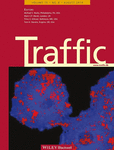Journal list menu
Export Citations
Download PDFs
Issue Cover
Issue Cover (August 2014)
- First Published: 21 July 2014
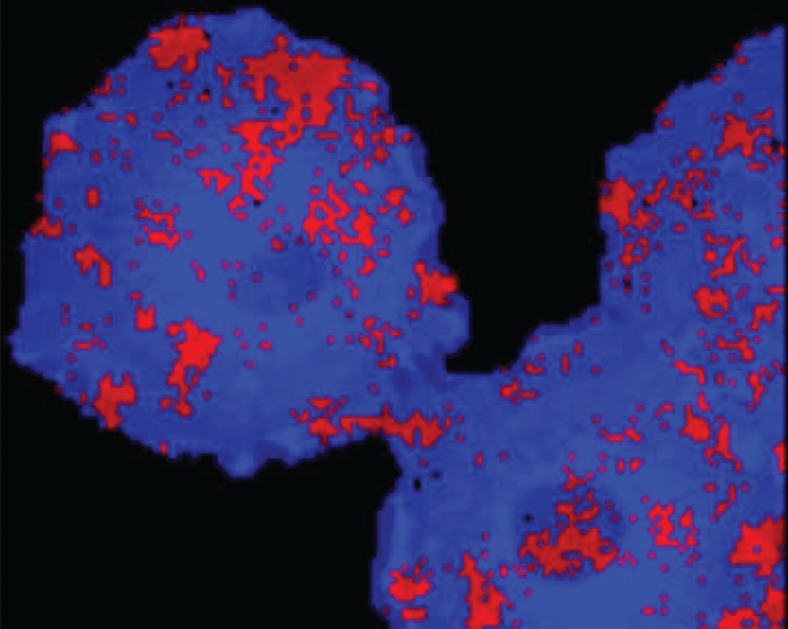
Cover legend: Dynamin oligomerization in cells detected by fluorescence lifetime imaging microscopy. Cos-7 cells expressing dynamin were treated with 30 μM Bis-T-23 (small molecule) which induces dynamin oligomerization into rings. After 20 min, cells were fixed and stained using monoclonal anti-GTPase antibody conjugated with Alexa Fluor 488 (donor fluorophore) and monoclonal anti-PRD antibody conjugated with Alexa Fluor 594 (acceptor fluorophore). Lifetimes are shown as discrete colors: fast lifetimes between 0–2200 ps represent ≥20% fluorescence resonance energy transfer (FRET) efficiency and are shown in red, whereas slow lifetimes above 2201 ps are shown in blue (no FRET). Positive FRET signal was only detected when dynamin oligomerized. In COS-7 cells, dynamin oligomers (positive signal) were detected throughout the cytoplasm, at the transition zone in which cortical actin transitions to stress fibers, and often at the cytoplasmic face of the nuclei. See Gu et al. Traffic 15(8): 819–838.
Read the full article on doi:10.1111/tra.12178
Issue Information
Review
In Sickness and in Health: The Role of TRAPP and Associated Proteins in Disease
- Pages: 803-818
- First Published: 10 June 2014
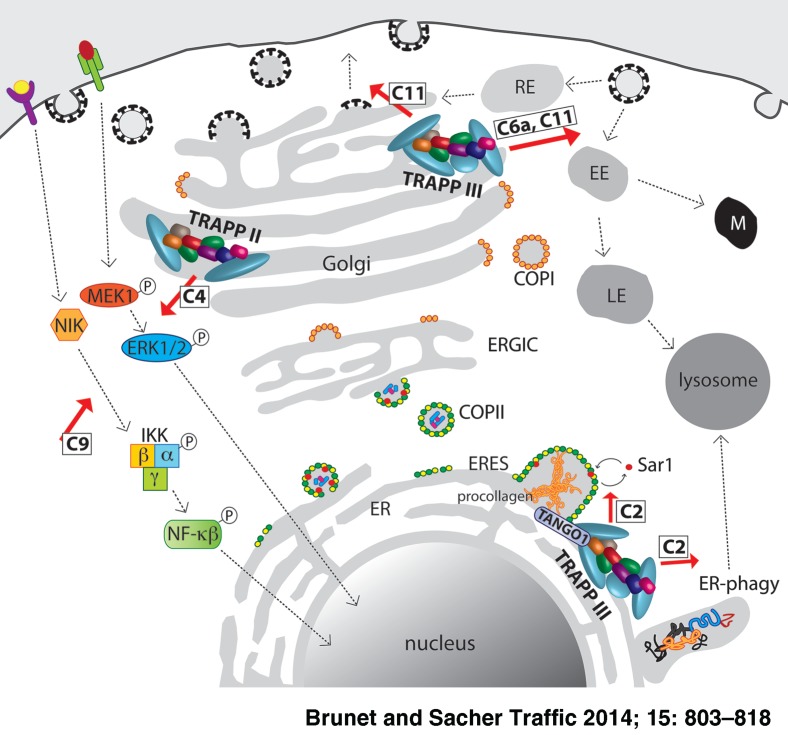
The TRAPP complexes are evolutionarily conserved molecular machines that participate in several membrane trafficking events. Mutations in TRAPP subunits have been documented in individuals with diverse disorders and appear to affect several pathways. This results in phenotypes displayed in multiple tissues such as cartilage, brain and muscle. Collectively, this suggests that the subunits may have tissue-specific functions either within or separate from their roles in TRAPP. Here we summarize what is presently known about TRAPP subunit mutations and offer explanations for the tissue-specific phenotypes seen.
Original Articles
Regulation of Dynamin Oligomerization in Cells: The Role of Dynamin–Actin Interactions and Its GTPase Activity
- Pages: 819-838
- First Published: 30 May 2014
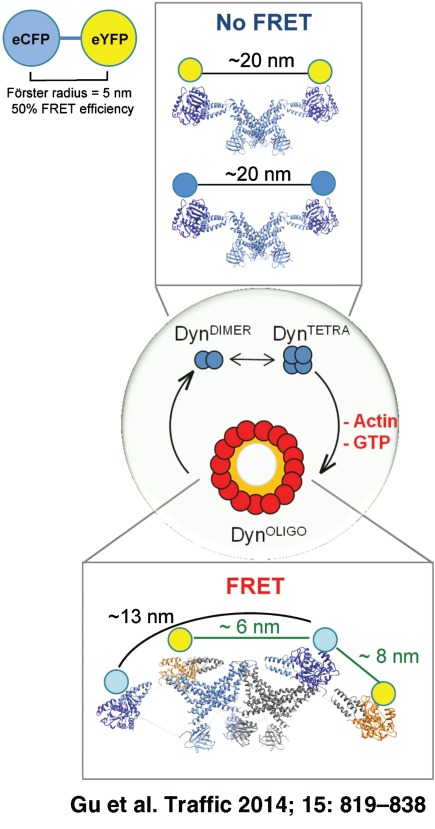
The GTPase dynamin has multiple oligomerization states. Here we show using fluorescence lifetime imaging microscopy that dynamin oligomerizes into higher order oligomers such as ring at distinct cellular sites which include the cell membrane and transition zones where cortical actin transitions into stress fibers. Detected dynamin oligomerization in the cell was dependent on direct dynamin–actin interactions, status of the actin cytoskeleton and GTP binding, but independent of active endocytosis. This study identifies a novel mechanism for dynamin oligomerization in the cell.
DKWSLLL, a Versatile DXXXLL-Type Signal with Distinct Roles in the Cu+-Regulated Trafficking of ATP7B
- Pages: 839-860
- First Published: 15 May 2014
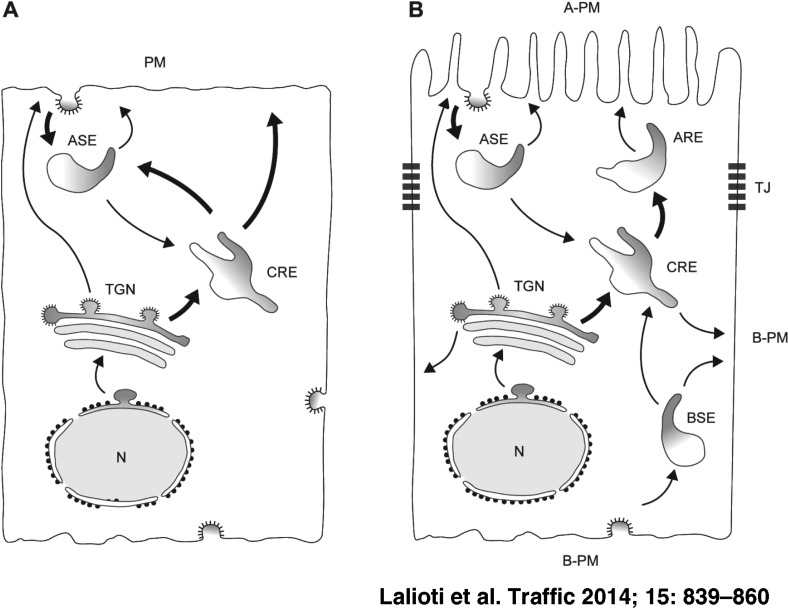
The function of ATP7B is tightly linked to its Cu+-regulated trafficking between the trans-Golgi network (TGN) and the plasma membrane. Mutations that disrupt ATP7B trafficking are among the causes of Wilson's disease. We have characterized the structural determinants that endow the DKWSLLL signal with the versatility to mediate the Cu+-regulated trafficking and distribution of ATP7B in the cell. The figure shows the potential traffic routes of ATP7B in non-polarized (A) and polarized cells (B). Endoplasmic reticulum (ER); trans-Golgi network (TGN); common recycling endosomes (CRE); apical recycling endosomes (ARE); basolateral sorting endosomes (BSE); apical sorting endosomes (ASE); tight junctions (TJ); nucleus (N); plasma membrane (PM); apical-plasma membrane (A-PM); basolateral-plasma membrane (B-PM). DKWSLLL-mediated trafficking steps (thick arrows). Fig. adapted from ref. 32.
PLCγ1–PKCγ Signaling-Mediated Hsp90α Plasma Membrane Translocation Facilitates Tumor Metastasis
- Pages: 861-878
- First Published: 04 June 2014
The regulatory mechanism of Hsp90α's plasma membrane translocation during tumor invasion remains poorly understood. Here our study provides a mechanistic basis for the role of PLCγ1-PKCγ pathway in regulating Hsp90α plasma membrane translocation, which facilitates tumor cell motility and promotes tumor metastasis.
USP8 Controls the Trafficking and Sorting of Lysosomal Enzymes
- Pages: 879-888
- First Published: 03 June 2014
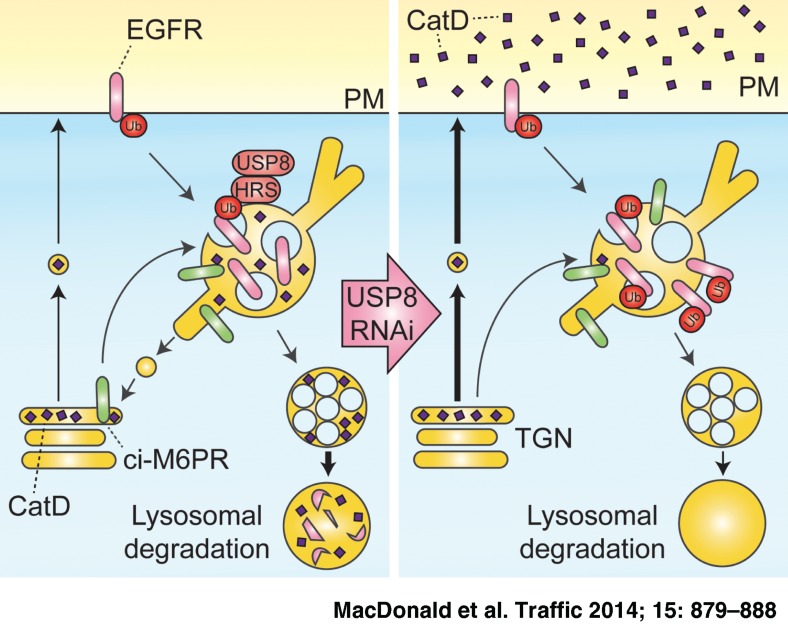
The endosomal deubiquitylase, USP8, controls many aspects of the endocytic pathway. These include stability of the ESCRT-0 complex and governance of the fate of activated receptor tyrosine kinases such as EGFR. Here we extend this reach to the recycling of ci-M6PR from endosomes to Trans-Golgi network. Following USP8 depletion, ci-M6PR accumulates in endosomes. The consequent secretion of cathepsin D into the extracellular milieu may provide a pharmacodynamic marker for USP8 inhibitors, which are under development.




